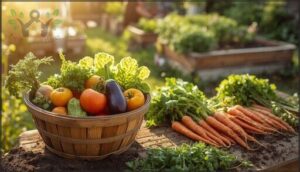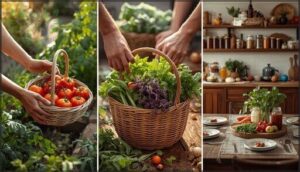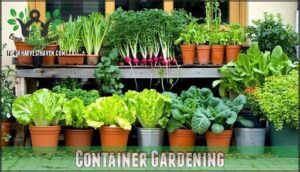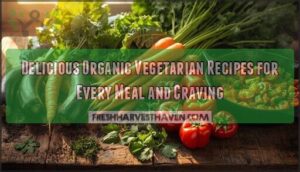This site is supported by our readers. We may earn a commission, at no cost to you, if you purchase through links.
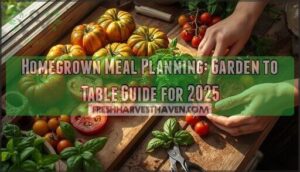
When you start homegrown meal planning, kitchen routines begin to rotate around what’s ripe, not what’s plastic-wrapped. Your plate fills up with color, your hands get a little dirt under the nails, and suddenly dinner is as much about wellness as it is about flavor.
The journey from soil to supper changes how you eat, move, and feel—one season, one harvest, one meal at a time.
Table Of Contents
- Key Takeaways
- Planning Homegrown Meals
- Benefits of Homegrown Food
- Garden to Table Systems
- Meal Planning Strategies
- Space Saving Gardening
- Overcoming Gardening Challenges
- Sustaining Homegrown Meals
- Frequently Asked Questions (FAQs)
- Who is homegrown foods?
- What is meal planning?
- Is weekly meal planning a good idea?
- What is a weekly meal plan?
- How do you make a sustainable meal plan?
- Can meal planning help you eat healthy at home?
- How much garden space needed for family meals?
- When to start seeds for year-round harvesting?
- How to budget for initial gardening setup costs?
- What backup plans when crops fail unexpectedly?
- Conclusion
Key Takeaways
- Planning your meals around what you grow helps you eat fresher, healthier food and keeps waste to a minimum.
- Starting a home garden gives you more control over nutrition, encourages physical activity, and reduces stress.
- Smart strategies like season-based recipes, food preservation, and meal planning apps make the most of every harvest.
- Even small spaces or limited sunlight can support productive gardens using container, raised bed, or vertical growing methods.
Planning Homegrown Meals
Planning homegrown meals starts with three key steps that work together. You’ll need to think about your garden setup, pick crops that match your space and eating habits, and map out a meal calendar that follows your harvest schedule.
Let’s look at each step so you can turn your backyard into a reliable source of fresh ingredients.
Setting Up a Garden
Imagine this: you’re standing in your backyard with a shovel in hand, about to turn a patch of grass into your family’s personal produce aisle. First things first—find a spot with six hours of sunlight and easy water access.
Soil preparation matters most here. Test your pH levels and work in compost to boost soil health. Your garden layout should be flat and wind-protected.
Gather basic tools like a spade, rake, and hose. This foundation sets you up for sustainable gardening success.
Choosing The Right Crops
Once your garden’s foundation is ready, the real fun begins—picking what you’ll actually grow and eat. Start with Climate Considerations by checking your USDA zone to match plants with your weather patterns. This simple step boosts Yield Expectations considerably. Next, think about Space Availability and Garden Design—do you have room for sprawling pumpkins or just container tomatoes?
Your crop choices should align with your Homegrown Meal Planning goals:
- Soil Requirements – Test pH and nutrient levels before planting
- Pest Resistance – Choose hardy varieties that naturally fend off common bugs
- Garden to Table timeline – Pick fast-growing crops like lettuce for quick wins
- Crop Rotation potential – Plan ahead to keep soil healthy season after season
Select Fresh Ingredients you’ll actually cook with to make every harvest count.
Creating a Meal Calendar
With your crops selected and soil prepped, the next step is organizing when you’ll actually cook with what you grow. A harvest calendar paired with calendar templates helps you match Garden Harvests to your weekly meals.
Recipe integration becomes easy when you plan around what’s ripe. Use meal planning apps to generate grocery lists for items you can’t grow. This time management approach aids budget adherence while making Gardening and Meal Planning work together seamlessly.
Benefits of Homegrown Food
Growing your own food isn’t just about having fresh tomatoes on hand. It transforms how you eat, move, and feel every single day.
Let’s look at three ways homegrown meal planning improves your life beyond what’s on your plate.
Nutritional Value
Homegrown produce delivers nutritional power that no grocery store can replicate. When you pick vegetables at their peak ripeness, you’re capturing vitamins, minerals, and antioxidants at their absolute highest levels. Spinach loses over half its vitamin C within a week of harvest, but your garden-fresh greens go from soil to plate in minutes. That’s the garden-to-table advantage.
Eating garden-fresh produce means capturing peak flavor and nutrition that store-bought vegetables simply can’t match
Here’s what makes your homegrown ingredients nutritionally exceptional:
- Vitamin Retention peaks when you harvest ripe and eat immediately
- Mineral Density increases because you control soil nutrition and quality
- Antioxidant Levels remain highest in freshly picked tomatoes and peppers
- Bioactive Compounds stay intact without commercial storage or transport
- Folate Content in leafy greens stays plentiful with minimal time between garden harvests and meals
You’re creating nutrition and wellness with every bite of fresh ingredients from your own backyard, supporting healthy eating in the most direct way possible. As local crops offer more nutrients than imported ones, opting for homegrown produce maximizes health benefits.
Physical Activity
Tending your garden delivers serious fitness benefits wrapped in the joy of growing food. You’ll burn 165 to 220 calories in just thirty minutes of digging, planting, or weeding—matching the calorie expenditure of weight training. This physical activity strengthens muscle groups through repeated squatting and lifting while boosting cardiovascular health and reducing diabetes risk.
Gardeners who spend 15 to 33 hours weekly during peak growing months meet exercise guidelines while growing fresh ingredients for home cooking. Your garden harvests support nutrition and wellness from soil to table, turning everyday garden-to-table work into a sustainable fitness routine.
In fact, gardening can be as effective as walking or cycling with respect to calorie burn.
Stress Relief
Research shows that gardening delivers measurable cortisol reduction—up to 22% after just thirty minutes outdoors. Your homegrown meal planning connects nature therapy with kitchen efficiency, transforming garden-to-table routines into powerful stress relief. Here’s how this mental wellbeing boost happens:
- Direct cortisol reduction through hands-on gardening lowers your stress hormone levels more effectively than indoor activities
- Enhanced nature connection strengthens emotional resilience while you gather fresh ingredients for meal prep
- Community gardens support increases social bonds by 12%, amplifying stress relief beyond solo gardening
- Therapy interventions using horticultural practices reduce anxiety symptoms by 40% in clinical settings
- Purposeful meal planning from your harvest creates daily satisfaction, linking physical activity to meaningful nourishment
Growing your own produce transforms simple tasks into mindfulness moments that calm your nervous system naturally.
Garden to Table Systems
Getting food from your garden to your dinner table isn’t complicated, but it does require a bit of planning. You’ll want to think about what your plants need to thrive, when they’re ready to harvest, and how to keep that bounty fresh beyond harvest day.
Let’s look at three key factors that make a garden-to-table system work smoothly.
Growing Conditions
Think of your garden as a living ecosystem where each element works together like instruments in an orchestra. Soil health acts as the foundation, so enrich it with compost to feed your plants naturally.
Most vegetables need six hours of sunlight daily, though leafy greens tolerate shade better. Water deeply but less often to encourage strong roots.
Use companion planting and crop rotation to manage pest control without chemicals. Understanding your climate impact helps you time plantings perfectly, while vertical gardening maximizes limited space for organic farming success.
Harvest Schedules
When you know exactly when each crop hits its peak, you can plan meals around the freshest flavors your garden has to offer. A harvest calendar helps track prime timing for each crop family, from tomatoes to greens.
Regional variations matter since your first frost date determines peak seasons. Use succession planting to stagger harvests every two weeks, ensuring continuous garden harvests for garden-to-table meals.
Strong harvest management and planning means you’ll always have fresh ingredients ready when you need them most.
Preservation Methods
Preserving your harvest transforms fleeting summer abundance into year-round nourishment for your family. You’ll master key food preservation methods that maintain up to 98% of nutrients while extending shelf life dramatically. These preservation techniques turn garden-to-table meals into a year-round reality.
- Dehydrating Foods removes 95% of water content, creating shelf-stable herbs, tomatoes, and fruit snacks that last months
- Canning Techniques use pressure or water bath methods to safely store salsas, jams, and pickled vegetables
- Fermentation Methods create probiotic-rich sauerkraut and kimchi while preserving cabbage for up to 12 months
- Root Cellaring maintains ideal temperature and humidity for freezing produce like potatoes and apples through winter
Smart food preservation and storage means you won’t waste a single tomato.
Meal Planning Strategies
Once you’ve got fresh produce coming in from your garden, the next step is putting it to good use on your plate.
Smart meal planning strategies help you make the most of your harvest without letting anything go to waste.
Let’s look at three practical approaches that’ll keep your garden-to-table meals running smoothly all season long.
Seasonal Recipes
Your garden’s harvest schedule is actually your best meal planning partner, naturally guiding you toward what’s ripe and ready to eat. Spring brings tender lettuce for Spring Salads and herbs for bright flavors. Summer means juicy tomatoes and peppers ready for Summer Grilling. Fall delivers squash perfect for Autumn Soups, while Winter Stews make use of your preserved harvest. This Seasonal Eating approach keeps your Garden-to-Table meals exciting and nutritious.
| Season | Garden Harvests | Seasonal Cooking Ideas |
|---|---|---|
| Spring | Lettuce, herbs, radishes | Fresh Ingredients for salads, pesto |
| Summer | Tomatoes, peppers, zucchini | Grilled vegetables, fresh sauces |
| Autumn | Squash, pumpkins, root vegetables | Hearty soups, roasted dishes |
| Winter | Preserved goods, stored produce | Comforting stews, Holiday Baking |
Meal Planning Apps
Managing your harvest without the right tools feels like trying to solve a puzzle with missing pieces, but meal planning apps bridge that gap perfectly. These digital helpers excel at Recipe Management designed to your garden’s output. Plan to Eat lets you drag recipes into weekly slots while generating Shopping Lists for only what you can’t grow yourself. Smart App Integrations track homegrown ingredient availability, and Dietary Filters highlight vegetable-forward options.
Key features include:
- Custom recipe storage synced with harvest schedules
- Automatic shopping list adjustments based on garden inventory
- Cost Tracking that shows grocery savings from homegrown produce
- Seasonal meal planning strategies aligned with crop rotation
- Ingredient substitution suggestions using available harvests
You’ll spend less time planning and more time enjoying fresh meals.
Reducing Food Waste
Apps simplify planning, but food waste reduction makes the real difference. American households toss nearly $1,900 worth of food annually—that’s money down the drain. Inventory tracking helps you avoid wasteful shopping trips by showing what’s already in your fridge before you hit the store. Check your garden harvests first, then build meals around what needs eating soon.
Portion control matters more than you think. Studies show careful meal planning can cut daily food waste to just 3 grams per household. Start by harvesting only what you’ll use that week. Those overripe tomatoes? They’re perfect for sauce. Wilted greens work great in smoothies.
Composting methods turn unavoidable scraps into garden gold, while preservation techniques like canning and freezing keep your bounty fresh for months. Even simple food preservation—freezing herbs in ice cube trays or dehydrating excess peppers—extends your garden-to-table system year-round.
Space Saving Gardening
You don’t need acres of land to grow your own food. Small-space gardening techniques let you get the most out of every inch you have, whether that’s a patio, balcony, or tiny backyard.
Here are three practical approaches that turn limited space into productive growing areas.
Container Gardening
With a few pots and the right seeds, you can turn even the smallest corner into a mini harvest waiting to happen. Pick container-friendly plant varieties—container tomatoes or herbs are favorites.
Focus on soil selection, the right container size, and smart watering techniques. Don’t forget pest control, even for urban gardens.
Good container garden design and planning will boost your garden yield, making gardening for beginners a real joy.
Raised Garden Beds
If you like the idea of container gardening but crave a bit more space and control, raised garden beds might be just what your meals—and your back—have been missing. With the right bed material options and smart bed height, you’ll enjoy easy planting and better pest control. Balanced soil composition and drainage solutions make garden harvests reliable for year-round GardentoTable meals. Try these gardening tips:
- Choose rot-resistant bed materials
- Mix soil for drainage and nutrition
- Raise beds for comfort
- Use covers for preservation techniques
- Compost to reduce food waste
Vertical Gardening
From tomatoes trailing up a trellis to peas winding skyward, sometimes the best way to grow fresh food is to let your plants reach for the clouds. Vertical gardening turns fences and walls into productive spaces. Choose vines or compact varieties for smart plant selection. Pair sturdy trellises with drip irrigation systems for easier pest control and less water waste. With thoughtful garden design and planning, even the smallest balcony becomes a GardentoTable oasis.
- Lush cucumber vines draping a balcony railing
- Strawberry pots stacked sky-high
- Pole beans dancing up a handmade net
Overcoming Gardening Challenges
Growing your own food comes with a few bumps in the road, but nothing you can’t manage. Every garden faces its share of space and sunlight puzzles.
Here are some straightforward solutions to help you keep growing, no matter your setup.
Limited Space
Who says a postage-stamp patio or tiny apartment has to stand between you and a harvest of fresh flavors? Balcony gardens let you grow container tomatoes, herbs, and leafy greens with just a bit of sun and a few well-placed hanging baskets.
Indoor herbs thrive in windowsill gardens, adding a burst of life to any kitchen.
Urban gardening shines when you use vertical gardening and smart garden design and planning, so even limited space can bring homegrown produce—and smart crop rotation—right to your table.
Limited Sunlight
Even when the sun doesn’t stick around for long, there are still plenty of ways to coax crisp greens and flavorful herbs from those shadowy corners. Smart crop selection—think Shade Tolerant lettuce or spinach—gets the most out of dappled light.
- Vertical gardening for sunlight maximization
- Reflective surfaces near plants
- Artificial lighting for a fresh garden indoors
- Harvest schedule for steady homegrown produce
- Container tomatoes by brightest windows
No Yard Solutions
Think you can’t grow your own food without a backyard? Think again—your kitchen windowsill or balcony can become a mini farm bursting with flavor. Windowsill Greens and Indoor Herbs thrive beside a sunny sink.
Balcony Gardens pile high with Container Tomatoes and greens. Don’t forget Community Gardens or Hydroponic Systems—each offers lush options.
With smart Vertical Gardening and handy gardening tips and techniques, your Garden Kitchen is always in season.
Sustaining Homegrown Meals
You’ve got fresh veggies on the table, but how do you keep that going all year?
Let’s take a look at a few ways to make your homegrown meals last longer. Here’s what to keep in mind as you plan for the seasons ahead.
Continuous Harvesting
You know that feeling when your garden just keeps on giving? That’s the magic of continuous harvesting. Mastering crop management through succession planting and clever seed selection means you’re never staring down a vegetable glut. Build a harvest calendar, time your picks for peak flavor, and savor yield maximization from early spring right into the fall. Your garden kitchen never gets dull.
- Fresh greens, week after week
- Gentle morning garden strolls
- Soil optimization with every planting
- Seasonal eating, always on your table
Crop Rotation
Ever wonder why some gardens seem to thrive while others stall out? The secret is often a simple shuffle—rotating crops to keep soil rich and pests guessing.
Smart rotation planning fosters soil health and nutrient cycling, limits pest control headaches, and stretches your garden harvests.
Companion planting boosts yields and sets the stage for a truly sustainable, homegrown meal planning system from farm to table.
Preserving The Harvest
Once you’ve worked hard to get every last tomato and pepper from your garden beds, it feels great to know nothing goes to waste. That’s where smart preservation methods come in—like canning techniques for vegetable gluts, easy freezing methods, or using dehydration tips for herbs.
Fermentation benefits gut health and stretches your bounty, while root cellaring keeps produce crisp deep into winter.
Build your harvest calendar around these strategies, and food waste reduction becomes second nature.
Frequently Asked Questions (FAQs)
Who is homegrown foods?
Homegrown Foods brings the Local Food Movement straight to your doorstep.
This Minneapolis service delivers organic, garden-fresh dinners to five states, combining Farm-to-Table values, sustainable agriculture, and easy home cooking for real food security and flavor.
What is meal planning?
Picture your week as a blank canvas—meal planning fills it with purpose.
It’s all about choosing your recipes ahead, planning Nutrition Planning, prepping ingredients, and using smart Meal Planning Strategies to save time, money, and reduce food waste.
Is weekly meal planning a good idea?
Weekly meal planning is a major advantage for Time Savings, Budget Control, and Stress Reduction.
With a plan, you can embrace Healthier Choices, add Dietary Variety, and sharpen your Time Management—all while solidifying Healthy Eating Habits.
What is a weekly meal plan?
Much like a GPS for busy kitchens, a weekly meal plan outlines what you’ll cook, when, and how.
This practice ensures planning benefits like time saved, budget adherence, and recipe variety—all designed to support healthy eating.
How do you make a sustainable meal plan?
Start with recipes built around seasonal produce and pantry staples. Choose dishes with overlapping ingredients to reduce food waste.
Stretch protein across meals, include a backup plan, and focus on local sourcing for true Eco-Friendly Eating.
Can meal planning help you eat healthy at home?
Meal planning streamlines home cooking, helping you tailor recipes to your dietary needs and portion control goals.
With a plan, it’s easier to enjoy healthy meal choices, mindful eating, and stick to a balanced diet at home.
How much garden space needed for family meals?
A simple 4×4 foot raised bed—a cornerstone of efficient garden layouts—can keep fresh greens and herbs on your table.
Even container gardens on a sunny patio support family food needs, boosting yield and meal frequency.
When to start seeds for year-round harvesting?
Savvy seed starters stagger their sowing: cool crops thrive when planted every couple of weeks, while heat lovers get a head start indoors under grow lights six to eight weeks before local frost dates—unlocking year-round, garden-to-table harvests.
How to budget for initial gardening setup costs?
Container gardening kicks off your homegrown meal planning journey without breaking the bank. Choose DIY over store-bought beds, hunt for free resource options, and explore community gardens.
Seed saving strategies cut startup costs—FarmtoTable can start with just a few pots!
What backup plans when crops fail unexpectedly?
Imagine walking into your kitchen, garden baskets empty after a surprise frost.
Smart homegrown meal planning means leaning on emergency food supply, cultivating alternative crops, partnering with community gardens, and supporting local farmers markets for sustainable food systems.
Conclusion
Like a well-tended garden, homegrown meal planning rewards patience and small, steady efforts. Every bite tells the story of seed, sun, and simple routines that nurture body and spirit alike.
You’ll find your rhythm changing with the seasons, meals brightening with what you bring in from outside, and your kitchen coming alive in unexpected ways.
There’s no shortcut—just honest work, good food, and a deeper connection to everything you grow and gather, right from home.


